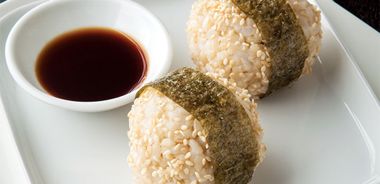Sumo Sushi

These rolled sushi balls make a perfect family-friendly meal. Getting young chefs to participate in filling and rolling their own sushi is a great way to get kids interested in cooking and involved in mealtime preparations.
1 tsp (5 mL) coconut oil
1/4 lb (125 g) ground chicken
1 tsp (5 mL) low-sodium soy sauce or tamari sauce
1/4 tsp (1 mL) toasted sesame oil
2 cups (500 mL) baby spinach leaves
1/4 cup (60 mL) prepared kimchi, finely chopped
1 green onion, finely sliced
1/2 tsp (2 mL) hot sauce (optional)
2 cups (500 mL) prepared sushi rice (see recipe for Sushi Rice)
1 Tbsp (15 mL) toasted sesame seeds, for garnish
2 sheets of nori, cut into 3/4 in (2 cm) strips, for garnish
Preheat coconut oil in frying pan over medium heat. Add chicken and sauté until cooked through, about 4 minutes. Stir in soy sauce, sesame oil, spinach, and kimchi. Continue to cook, stirring frequently, until spinach has wilted, about 2 minutes. Stir in green onion and hot sauce (if using) before transferring mixture to bowl. Refrigerate until cool enough to handle.
Dampen hands to help prevent rice from sticking to them while forming balls. Gather approximately 3 Tbsp (45 mL) rice and press into a patty roughly the size of your palm. Place 1 Tbsp (15 mL) chicken filling in centre of rice and fold up edges to enclose filling and patch any holes with extra rice. Roll between your hands a few times to achieve a round ball. Set aside on plate and cover with slightly damp cloth while forming remaining rice balls.
Sprinkle tops with sesame seeds before wrapping a strip of nori around each.
Serves 10.
Each piece contains: 74 calories; 3 g protein; 2 g total fat (1 g sat. fat, 0 g trans fat); 10 g total carbohydrates (0.5 g sugars, 1 g fibre); 47 mg sodium
Fanciful fillings
The sky’s the limit when you’re creating flavourful fillings for Sumo Sushi. Try these noteworthy combinations or simply get creative with last night’s leftovers.
- chives, lemon zest, smoked salmon, green onion, and capers
- cooked spinach, tahini, mirin (a rice wine), soy sauce, and finely chopped almonds
- scrambled egg, fish sauce, green onion, cooked crab meat, and chili powder
- cooked shrimp, avocado, lime zest, cilantro, red onion, and jalapeno
source: "Summer Sushi", alive #380, June 2014





